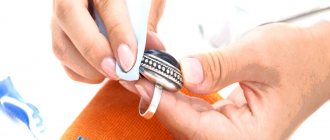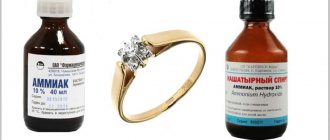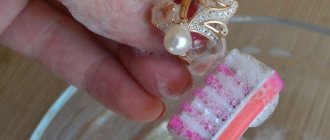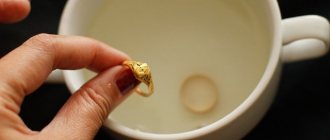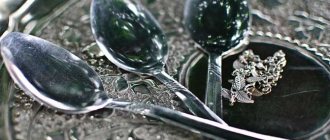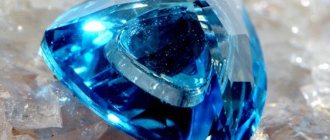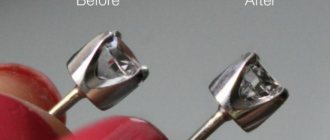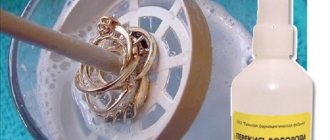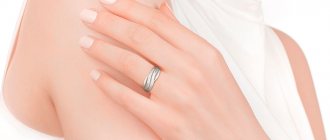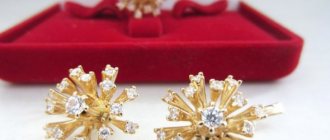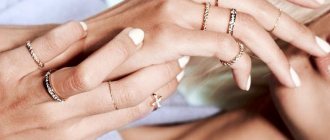Preparing for cleaning
To clean silver at home, you need to accurately determine the composition and sample of the metal, choose the right product and processing method.
Getting started with cleaning:
- Inspect the decoration and assess the degree of contamination.
- Choose a cleaning method based on the type of product.
- Prepare everything you need for cleaning: a container with warm water, detergent, napkins, cotton pads and swabs, dry flannel or velvet.
- Soak the items in warm soapy water for 10–20 minutes. for preliminary removal of dust, softening dirt, degreasing the surface.
If there is heavy soiling, especially on jewelry with stones, consider taking it to a jewelry store. Professionals using special means will be able to remove damage, restore an attractive appearance and restore the protective coating of the metal.
Features of cleaning different types of silver jewelry
The choice of cleaning method for products must be made based on their characteristics; below are some rules:
- For products with ornaments, it is recommended to regularly carry out preventive procedures:
- It will be enough to remove dust every day, as well as rinse in a soapy solution once a week.
- If there is serious dirt or plaque, it is best to use toothpastes that are applied with toothbrushes, but be sure to check that their bristles are soft enough.
- Products that are inlaid with various precious stones require careful handling and care:
- To remove contaminants, the best option would be to prepare a solution, which can be obtained by diluting 10 ml of ammonia in a glass half filled with water.
- The decoration is immersed in the solution and kept in it for no more than 30 minutes.
- If the blackening and plaque disappear faster, the products will need to be immediately removed, rinsed with clean water and wiped with a paper napkin.
- If it is necessary to clean products with a smooth matte surface , it is strictly forbidden to use any products with an aggressive effect, including table salt or baking soda. They are capable of deforming the structure of the surface or leaving microscopic scratches on it, which leads to irreversible damage to the jewelry. To remove dirt, it is best to finely grate the soap and use the resulting shavings to prepare a soap solution.
Cleaning silver with special means
Professional products are used in jewelry workshops to care for silver items of any kind. Special gels, pastes, sprays, shampoos and wipes quickly and safely remove tarnish, restore shine, and create a protective film on the metal.
You can clean silver with these products at home. You need to use them to wipe off dirt yourself, carefully, strictly following the instructions, observing the dosage and exposure time.
Let's look at the most popular compositions that can be purchased in jewelry workshops.
Talisman
An effective product for cleaning silver jewelry:
- Place the products in a small container.
- Pour in the product so that it completely covers the items.
- After 1-2 minutes, rinse the silver in running water.
- Dry and polish with velvet.
If there are a lot of items, the solution can be reused.
The liquid is not suitable for cleaning blackened silver, as well as items with natural or artificial stones and gold plated.
Talisman can be ordered in the online store. Cost per package of 150 ml from 150 to 250 rubles. depending on the seller.
HG cream
Professional product for cleaning and adding shine to dishes, cutlery, and decorative elements. The cream effectively removes plaque, brightens blackened areas, polishes the surface without damaging the metal. Suitable for antique blackened silver items.
To clean dishes or decorations:
- Wash items in warm water and soap.
- Apply a little cream to a napkin and treat the surface.
- After 1–2 min. Polish the silver until it shines.
The price for a 125 ml package of cream is 500–550 rubles.
Silberpflege Centralin
A gentle paste for cleaning all precious and non-precious metals. Safe for sterling silver, blackened items, rhodium-plated or gold-plated jewelry. The product effectively removes plaque, brightens the metal, and creates a protective film against oxidation on the surface.
To clean silverware or jewelry:
- Apply a little paste to the sponge.
- Spread evenly over the surface. Leave for 2-3 minutes.
- Rinse under running water.
- Wipe dry.
A tube with a volume of 75 ml can be purchased for 250 rubles. in any online store.
When choosing a professional silver care product, consider the grade, type of metal and the presence of stones in the jewelry.
Silver cleaning products
Advantages of special products over homemade ones
Even under the correct storage conditions, it is impossible to completely prevent the appearance of blackness on silver. For cleaning, you can contact a jewelry workshop, but the services of these organizations are very expensive. The Internet is full of advice on how to clean silver items, suggesting the use of a variety of products from soda to toothpaste. However, not all owners of high-value items are in a hurry to conduct such “experiments” with them, running the risk of being permanently damaged.
So, soaking in ammonia or soda removes blackness, but does not return the original shine, and rubbing with toothpaste can, in addition to mechanical damage, lead to completely unpredictable consequences: additives to modern toothpastes sometimes simply destroy the top layer of silver, much less “remove” it forever. blackening.
Restoring the appearance of silver items after home cleaning in jewelry workshops is an expensive and slow process. Therefore, professional craftsmen advise using specially created preparations to clean silver at home. They are effective and completely safe for him. In addition, these compounds protect the metal surface for a long time, slowing down its oxidation processes.
Cleaning jewelry with stones
Turquoise
Pomegranate
Pearl
Emerald
Coral
Moon rock
Malachite
Ruby
Sapphire
Topaz
Amber
Jasper
Jewelry inlaid with precious or semi-precious stones requires careful selection of cleaning methods depending on their type:
- Aquamarine, emerald, sapphire are dense stones that are not afraid of high temperatures and active processing. To remove plaque, wipe the metal with alcohol and polish with soda.
- Turquoise, moonstone, malachite - have an average area; do not tolerate prolonged contact with water, rough friction and hot water. Soapy water, soda slurry or diluted alcohol are suitable for cleaning.
- Amber, mother-of-pearl, and pearls should not be washed with aggressive agents, boiled, or cleaned with brushes. To lighten silver, go over the surface with a school eraser and wipe the stone with a damp cloth. Aggressive compounds can cause pearls to turn yellow.
When starting to clean, find out what kind of stone is set in the ring or earrings. If accurate information is not available, wash your jewelry with warm water and soap or contact your jeweler.
How to clean silver with stones
How to clean a silver chain with baking soda
If you carefully care for your jewelry and do not allow heavy deposits to form, you can use the gentle dry cleaning method. To do this, you will need a paper towel or napkin and baking soda, which perfectly cleans many types of household stains.
When you have prepared everything you need, you can get to work. To manually clean your silver, do the following:
- Spread a paper towel on a flat surface.
- Pour baking soda onto the paper, spreading it evenly over the napkin.
- Place the decoration on top of the powder and wrap it in a napkin.
- Gently rub the chain wrapped in a paper towel using the same motions as when hand washing. Pay special attention to the part of the decoration where the darkened areas are located.
- Hold the softened tissue between your fingers and gently clean the blackened chain by pulling it through the paper and wiping.
When finished, remove the soda using a piece of soft cloth. If particles of the substance remain after this, it is permissible to rinse the jewelry in warm water.
How to clean blackened silver
Products made from blackened silver are distinguished by an abundance of decorative elements: recesses, grooves, and ornaments.
Such items require regular care to remove dust, dirt, and plaque.
To properly wash blackened silver at home:
- Pour 1 glass of warm water into a deep cup, add 2 tbsp. l. liquid soap.
- Add a pinch of salt.
- Mix thoroughly until the ingredients are completely dissolved.
- Immerse the silver in the solution and leave for 30 minutes.
- Gently clean the metal with a soft cloth.
If you need to freshen dishes, candlesticks, rings or any other items with a smooth surface, use a quick cleaning method using a school eraser. Spot-process the metal until it shines, being careful not to touch the blackened areas. Then, rinse with warm water and wipe dry with a soft cloth.
Old blackened silver heirlooms are more resistant to cleaning and polishing than new jewelry. Modern production technology involves chemically applying a thin film, creating the effect of darkening individual areas. With active exposure, the coating quickly wears off and white spots appear.
To clean blackened silver items, do not use acids, alkalis, abrasives, boiling water, or alcohol compounds.
Preparing the product for the procedure
Before you start cleaning silver, you need to determine the metal alloy and the material of the inserts, if any.
If the product contains pearls, corals or amber, home processing is contraindicated. You can only trust a professional to clean silver with such inserts. The fact is that these stones are very sensitive to available substances (acids, mixtures with abrasive particles, alkalis). Additionally, not all professional silver care products are suitable for cleaning pearl or coral jewelry. To give them their original appearance, it is better to contact an experienced craftsman who can delicately process the silver frame without affecting the inserts.
The appearance of pearls can easily be ruined by unprofessional cleaning of silver at home
Before performing the procedure, you need to remove all dust, grease, cosmetics and other easily removable contaminants from the silver surface. This can be done using any dishwashing liquid, a toothbrush and a small container that will fit the entire product. To do this, it is recommended to follow the following algorithm:
- Fill a container with warm water and dilute dishwashing detergent in it to form a thick foam on the surface.
- Place the silver in the solution and leave for half an hour.
- Rinse off the soap suds from the product under running warm water, cleaning it with a toothbrush.
A large set of silverware can be soaked in a large basin overnight.
How to clean rhodium plated silver
Silver earrings or rings coated with rhodium, when properly cared for, are not subject to corrosion; they retain their appearance longer and do not darken. To clean them at home, do not use ammonia-containing, alkaline or acidic products.
The most effective and safest method:
- Prepare a soap solution from any foaming composition (liquid soap, dish soap, shampoo).
- If significant contamination is noticeable in the relief, fasteners, or hard-to-reach places, leave the silver in the composition for 10–15 minutes. Rinse under running water.
- Dry with a soft microfiber or flannel cloth.
- To make silver shine, apply a few drops of glycerin to a cotton swab and treat the metal. Polish with velvet.
Soap and glycerin degrease the surface well, remove plaque and dirt, and restore shine. In addition, the method is safe for products with stones.
Rules for cleaning silver using ammonia
Ammonia is considered one of the best means for removing plaque, dirt and discoloration. The reason is that ammonia is also an excellent solvent, which allows it to easily cope with complex silver stains.
During the cleaning process, the substance reacts with oxidizing agents (remember, they are the main cause of plaque formation), and as a result of exposure they are converted into ammonium salts. The metal cannot be harmed; ammonia is completely safe for it. In addition, this substance is highly volatile and quickly evaporates from the surface of silver.
The main thing is to follow a simple rule when working with ammonia, namely, do not soak jewelry in it for a long time. As a result of prolonged exposure to the chemical, the metal may change its color, for example, turn yellow.
Ammonia will do an excellent job of removing stains and deposits on silver without harming either the metal or your health if used correctly. How to clean silver with ammonia? Please note the principles of working with caustic compounds:
- during the cleaning process, protect your hands with gloves and your respiratory system with a medical mask, since ammonia has a caustic structure and a pungent odor;
- clean silver jewelry separately from items made of other metals, otherwise alloys of different densities and properties will undergo an unpredictable chemical reaction under the influence of ammonia (for example, silver may become yellow, and gold purified together with it may become white or pink);
- When cleaning, do not use rough, hard sponges; it is better to use a soft cloth, foam rubber, and in case of severe contamination, an old toothbrush;
- if the product has not darkened much, limit yourself to cleaning in a weak soap solution, and save ammonia for more serious stains;
- if there are stones on the jewelry, it is necessary to reduce the percentage of ammonia in the cleaning solution (no more than 5 drops per 200 ml of water), in addition, only durable and chemical-resistant stones, for example, diamonds, can be cleaned in this way;
- when stones are glued to metal, avoid cleaning methods that involve soaking the product in ammonia-based products, since this composition is a solvent and easily neutralizes the glue, as a result of which the stones will simply fall off;
- Do not use ammonia on items containing pearls or on gold-plated silver.
If you are not convinced that you can do everything correctly, or are not able to determine the origin of the stones on the product, it is better to seek professional help, excluding any experiments at home.
You can clean silver at home using ammonia according to one of these recipes:
- Aqueous solution of ammonia. Prepare a cleaning composition by mixing ammonia with water in a ratio of 1:10. Place decorations in this mixture; the time they remain in the solution depends on the degree of contamination. If the plaque is insignificant, 15 minutes will be enough, and if there is severe oxidation, the product can be kept in this liquid for up to 30 minutes. Then remove the silver from the ammonia solution, rinse under running water and wipe dry.
- Ammonia, chalk and soap. Make a weak soap solution and place the jewelry in it for 5-7 minutes. At this time, start preparing the cleaning paste, mix crushed chalk and ammonia so that you get a “gruel”. Remove the items from the soap solution, apply the paste to the silver, and when it hardens, rinse off the mixture and polish the item with a soft cloth.
- Ammonia and tooth powder (can be replaced with paste). The solution is prepared in the proportion of 2 parts ammonia to 5 parts water and 1 part powder or paste. The product must be mixed thoroughly, and then applied to the jewelry and cleaned off the remaining plaque and dirt. Afterwards, remove the composition under running water and wipe the silver with a soft cloth.
The last method of cleaning silver with ammonia is used for severe contamination, and it is also good for cutlery made of this metal. But it is strictly prohibited to treat products with stones with this composition.
If for some reason the listed methods do not suit you, and you do not want to contact a specialist, or do not have such an opportunity, you can use another cheap and safe recipe for cleaning tarnished silver with ammonia.
To carry out the work you will need:
- ammonia;
- hydrogen peroxide;
- filtered water.
To get your jewelry in proper shape, follow these instructions:
- Mix the ingredients in equal parts until a homogeneous mass is formed.
- Place the decorations in a container with the solution and leave until the plaque can be easily cleaned off or disappears on its own. However, remember that you can keep jewelry in ammonia for no more than 30 minutes.
- Remove the product and, if necessary, clean hard-to-reach areas or areas of particularly heavy dirt with a cotton swab.
- Rinse the silver in plenty of running water.
- Polish the surface using a soft cloth.
Do not forget that cleaning with “soaking” of products is best done only if the decoration does not have stones on the surface.
Precautions when working with ammonia
When working with ammonia, you must remember the caustic nature of the composition and take appropriate precautions:
- protect your face and hands from aggressive composition using gloves and a mask;
- use tweezers to place objects in the solution and then remove them;
- do not lean over the vessel with the cleaning solution, this can cause burns to the mucous membranes and chemical poisoning;
- work with ammonia only in a well-ventilated area, with open windows;
- If the composition comes into contact with unprotected skin, immediately rinse the area with plenty of running water.
How to clean matte silver
Matte silver items can be washed at home with soapy water or potato broth:
- Rinse and peel the tubers well. Cook it.
- Place decorations in a warm broth (without potatoes!). Leave for 2-3 hours.
- Wash the metal with a soft cloth and rinse well.
- Polish with velvet.
To remove grease and dust stuck in the relief:
- Prepare a thick paste from potato starch and water.
- Place a little mixture on a soft toothbrush and brush the jewelry.
- Rinse with warm water, wipe dry with a napkin.
To remove blackness from matte silver, use only soft compounds without abrasives. Boiling, pouring hot water, or rubbing with hard brushes is prohibited.
How to clean gold-plated silver
To clean gold-plated silver jewelry:
- Apply a little vinegar to a cotton pad.
- Carefully treat the surface. To wash the relief, clasps, frames, use a cotton swab.
- Rinse the metal under running water and polish.
To restore shine and brighten gold-plated silver when heavily soiled:
- Dissolve 1 tbsp in a glass of water. l. alcohol and 2 tbsp. l. vinegar.
- Soak the silver for 5-7 minutes.
- Clean with a soft brush and rinse thoroughly with running water.
The gilding layer is very thin. It can be easily damaged by abrasives or hard tools.
How to clean gold plated silver
Methods for cleaning silver
Having removed all surface contaminants from the silver item, you can begin the main cleaning, which will return it to its former shine, noble shade and delicate radiance. All methods for achieving this goal can be divided into two large groups: improvised and professional.
These methods have their pros and cons. Among the positive qualities of improvised means, one can note their cheapness and accessibility. Few people don’t have baking soda, toothpaste or citric acid on hand. Professional products will cost more, but they clean the metal more carefully and quickly.
Available tools for the procedure
If you don’t have the time, money or desire to purchase a professional product, you can get by with such simple household products as:
- Dentifrice. This method requires the usual and cheapest product. Nowadays you can most often find Special tooth powder in supermarkets. It is perfect for cleaning silver at home. To do this, use an old toothbrush to thoroughly wipe the product. Application of this method can take from half an hour to an hour (depending on the degree of contamination).
Tooth powder is not the fastest, but quite effective way to clean silver - Ammonia. This product is only suitable for slightly darkened products (to remove significant stains, it is better to choose soda or tooth powder). Dilute ammonia with water in a ratio of 1:10. After this, put the silver in the solution for 30–60 minutes (the holding time depends on the degree of contamination). Never keep metal in alcohol for more than an hour. Rinse the product under warm water to remove any remaining product.
- Soda. This is the most effective means at hand for cleaning blackened silver. Wet the item with water, put a little baking soda on a soft-bristle toothbrush and gently wipe the silver surface.
- Foil. To use this method, its aluminum culinary variety is suitable. This foil is great for removing light stains from cutlery. In addition to it, you will need one glass of soda. Dilute it in a large container, put a few pieces of foil there and place silverware in the container. After 15 minutes, the products can be rinsed under running water and wiped dry. The method allows you to make silver lighter without much effort, but is not suitable for removing hard-to-reach and stubborn stains.
Cleaning with foil is a fairly simple and effective method for silverware. - Lemon acid. This method is not suitable for cheap silver and products that include inserts made of base metals. If you have a bag of citric acid lying around at home, dilute three tablespoons of this product in a glass of warm water and place the silver in it. Boil the product for 15–20 minutes. Citric acid will slightly clean and brighten the surface, after which all you have to do is wipe the silver dry.
Professional preparations for silver purification
Using professional silver cleaning products is the best and most effective way to restore jewelry and cutlery to their original appearance at home. The composition of these drugs is not always safe for humans, so do not forget about simple precautions:
- use the product with gloves;
- hide it from small children;
- ventilate the room in which you are performing the procedure.
Talisman
Talisman is one of the most popular products for cleaning silver at home. It is available in the following forms:
- bottle (50 ml and 100 ml);
Talisman silver cleaner is available in 50 ml and 100 ml bottles - jar (a special form for cleaning silverware, including a mesh and a brush for hard-to-reach places);
Talisman in a jar is a traditional form of cleaning product for silverware at home. - cleaning wipes (a product for regularly wiping silver items).
Talisman wipes are great for regular product care
The method of using the liquid product is simple: place the silver in a container for a few minutes, then rinse thoroughly with warm running water and dry. The cost of small bottles with a volume of 50 ml is from 120 rubles, 100 ml – from 190 rubles. You can purchase Talisman at almost any jewelry or hardware store.
This brand also produces products for cleaning other metals and alloys: gold, cupronickel, platinum. The silver series is distinguished by blue labels.
Flurin
Flurin is a domestic product intended for cleaning silver and other precious metals. It is more aggressive than Talisman, so when using it it is strongly recommended to wear household gloves to avoid damaging the skin of your hands. Flurin is sold in containers of 100 ml, 125 ml, 150 ml. The average price of the smallest bottle is 290 rubles. The shelf life of the drug is 2 years, so you can purchase several packages in reserve.
Flurin can be purchased at a hardware or jewelry store
The method of using Flurin is similar to Talisman brand drugs. To do this, you just need to immerse the product in the composition, soak for 5-7 minutes, then rinse and dry.
It should be remembered that Flurin is not suitable for cleaning:
- silver with blackening;
- stainless steel products;
- products with inserts (pearls, corals, lapis lazuli, turquoise, malachite).
Flat
Flat is a universal cleaner that is suitable for both silver and other metals (platinum, gold, cupronickel, brass, copper, bronze). The cost of a standard package (130 g) is about 130 rubles.
Flat is an effective silver cleaner
The product has a pungent odor, so make sure the room is well ventilated in advance.
It's worth noting that Flat is best for cleaning coins and cutlery. Talisman cleans jewelry better (this is due to the consistency of the product). Flat has a thick texture, similar to liquid sour cream, and apparently does not always effectively penetrate into hard-to-reach places on jewelry.
Cleaning a product with enamel
To clean silver with enameled inserts, do not use aggressive agents, abrasives, or brushes.
To remove oxidation, use lipstick:
- Thoroughly lubricate the entire surface, indentations, protrusions, and fasteners.
- Leave for 10 minutes.
- Remove lipstick with a microfiber or flannel cloth.
Clean the frame specifically, being careful not to get it on the decorative elements.
Enamel does not tolerate prolonged contact with water, sunlight, acids, or alkalis.
Why does silver darken?
Before we start cleaning, let’s figure out why the products darken? There are several reasons:
- Human organism. The peculiarities of the human body provide for different degrees of activity of the sweat glands. This is why each person’s underwear darkens differently. For example, active sweating during sports or stress causes the color of the metal to change. The active secretion of sebum during hormonal changes also contributes to this. Sometimes a change in color can serve as a signal that there are problems with hormonal levels.
- Moisture. With frequent contact with water and on wet skin, jewelry fades much faster.
- Interaction with substances and cosmetics containing sulfur. Silver, coming into contact with sulfur, forms black compounds.
Additional recommendations
Proper care and storage will ensure the attractive appearance of jewelry, dishes, and cutlery.
What to do to prevent silver from tarnishing
Silver turns black when in contact with water, detergents, cosmetics, sweat, and other metals. To prevent jewelry from darkening:
- remove them before showering, bathing, washing or active training;
- wear rings, earrings and chains after applying cosmetics;
- store jewelry in a box, place them in separate cells or fabric covers.
Carry out preventive cleaning of even unused jewelry in a timely manner. Wash them in warm water and soap 2-3 times a year, wipe them thoroughly from moisture, and apply a protective coating.
What not to clean silver
High-quality 925 sterling silver will withstand cleaning with any detergent: alcohol, ammonia, soda, toothpaste. Only caustic household chemicals, bleaches, solvents, and hard abrasives are prohibited.
It is better to wash combined products, jewelry with coating, stones, and decorative inserts with soapy water or treat them with special products.
Silver is a capricious metal that is sensitive to environmental influences. Timely care, adherence to wearing rules and proper storage will help maintain its attractive appearance, shine and radiance.
Rules for storage, washing and use
Recommendations that allow you to preserve silver cutlery (including those with gold plating):
- after cleaning, items should sit for at least 3 days until a protective film forms;
- Products should be stored in a case with a velvet or other woven lining inside;
- devices must be kept away from sources of water, and the humidity level in the room must be normal;
- preventative cleaning should be carried out from time to time;
- You cannot use such devices for certain foods (eggs, mayonnaise, fish, etc.).
